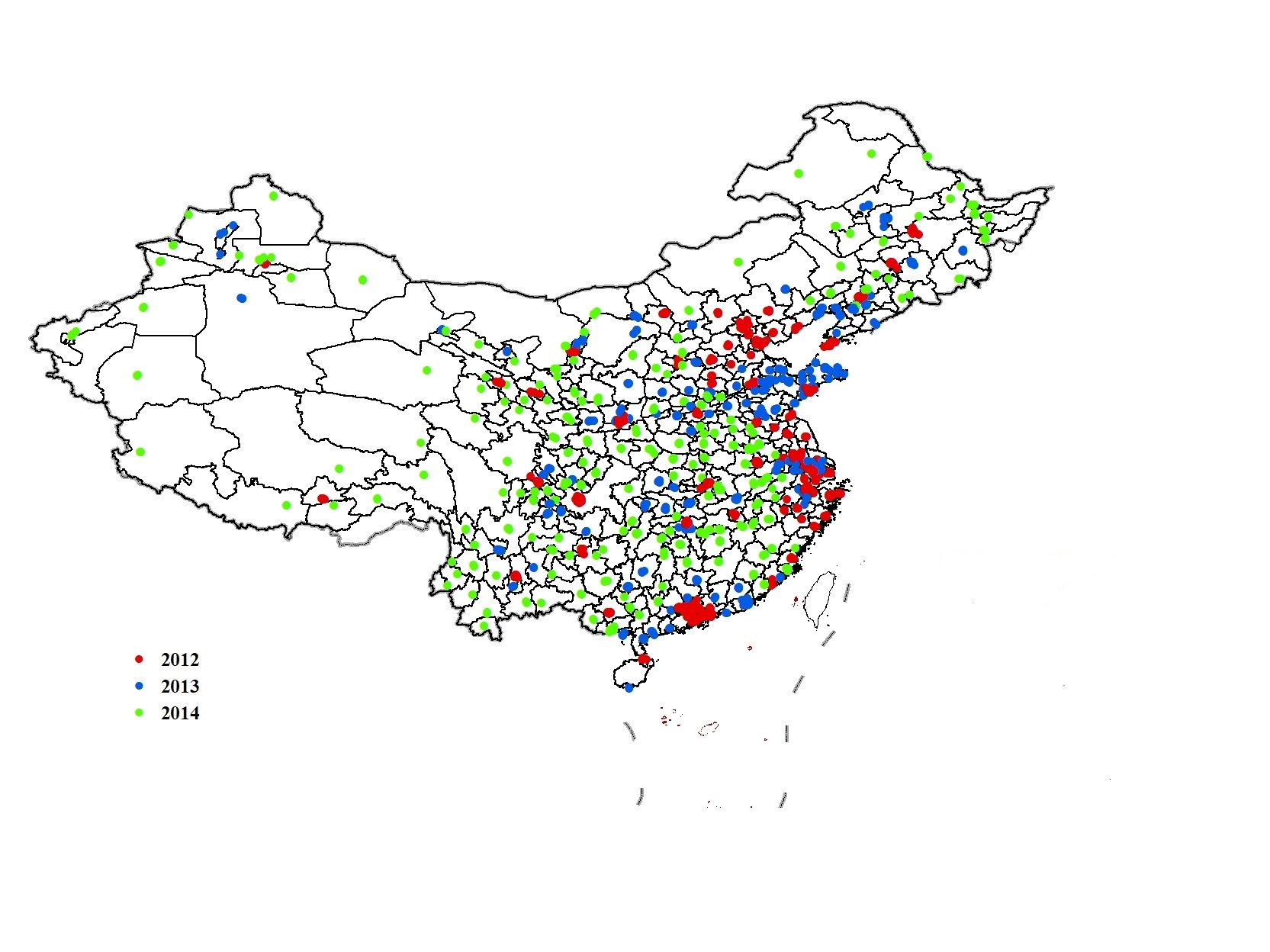
The advanced air quality monitoring system in China has led to improvements in local air quality, but also prompted local governments to strategically prioritise areas near the monitors in order to meet pollution control targets. This localised response poses a new challenge for enforcement and interpreting pollution readings from ground monitors.
In 2013, amidst public outcry over air quality, the central government of China declared a “war on air pollution”, implementing a series of regulatory policies described as the “strictest ever” (Greenstone et al. 2021). Local governments were subjected to increased incentives to achieve specific air pollution reduction targets set for the period 2013—2017.
The upgrading of the air quality monitoring system was part of the infrastructure support to enforce the stricter environmental regulations. The programme, which was introduced in December 2012 and implemented in three waves, not only improved accessibility to pollution information for residents (Barwick et al. 2023), but also strengthened the monitoring capabilities of higher authorities in assessing local governments' environmental performance (Greenstone et al. 2022). The upgraded monitoring programme brought about several key improvements:
- It acknowledged PM2.5 as a primary pollutant, giving priority to efforts aimed at combating its harmful effects.
- The monitoring network expanded from 113 to 335 cities between 2012 and 2014, ensuring a broader coverage of air pollution control efforts.
- The upgraded or newly constructed monitoring stations allowed for the direct transmission of accurate and reliable data to the central system, which addresses issues of potential data manipulation in the previous system and enhances principle-agent monitoring (Ghanem and Zhang 2014, Hölmstrom 1979).
Figure 1: The timeline of monitoring station automation

Despite significant scholarly and policy interest, there is limited empirical evidence on the effectiveness of technology-aided monitoring on the enforcement of environmental regulation. Our recent work (Yang et al. 2023) leverages the unique Chinese reform setting to assess these issues. Judging from ground monitor readings, the campaign has achieved remarkable success: the national-level PM2.5 levels declined by about 40% from 2014 to 2019 (Greenstone et al. 2021).
However, questions remain as to whether these achievements touted at the aggregate level are inflated by a localised pollution control approach targeting monitored areas. There is abundant anecdotal evidence suggesting that many local governments have indeed engaged in strategic cleaning measures. Upon searching a considerable number of government policy documents from the China Law Journal Database, it is revealed that 121 documents from 72 cities directly reference “atmospheric pollution control around monitoring station” accompanied by a diverse array of action plans. These plans explicitly outline several measures such as regulating coal use, suppressing dust through water spraying, restricting nearby traffic, prohibiting open burning and outdoor cooking, and shutting down major sources of pollution.
To gain a comprehensive understanding of air quality in both monitored and unmonitored areas, we primarily rely on fine-scale remote sensing data, which can fill the spatial gaps in ground monitoring networks by detecting pollution changes from space. We obtain ten years of observations on annual PM2.5 concentrations at a 1km by 1km resolution for the entire country of China. Employing a spatial difference-in-differences (DiD) design, our empirical approach consists of two layers. In the first layer, we leverage the staggered roll-out of the new automated monitoring system across cities to examine its impact on citywide pollution. The second layer forms the core of our analysis, where we compare areas located at different distances from monitoring stations within each city to assess how automation affects the pollution gap between monitored and unmonitored regions.
Our main finding, as presented in Figure 2, is that areas adjacent to automated monitors experienced a 3.2% decrease in PM2.5 concentrations compared to those farther away. The validity of the spatial DiD design is supported by the finding that prior to the automation, monitored and unmonitored areas exhibited very similar pollution trends. The gap between the two groups emerged after the start of the new monitoring system and grew even larger as the final assessment deadline set by the central government approached.
Figure 2: The effect of automated monitoring on air pollution within 3km of a monitor

In contrast, the impact of upgraded monitoring on city-wide average pollution appears to be less significant. Figure 3 illustrates that overall pollution levels in treated cities decreased slightly after joining the automatic monitoring system, but the coefficients are statistically insignificant.
Figure 3: The effect of automated monitoring on city-level pollution

We then use a ring analysis to assess the spatially differentiated pollution pattern within the treated cities. Figure 4 demonstrates that as the distance from the monitors increases, the pollution reduction in response to automation decays and eventually becomes insignificant. Notably, in the outer rings, there is a positive effect on pollution reduction. These ring-based results are broadly consistent with the overall findings of limited impact of monitoring programme on city-wide pollution.
To examine the heterogeneous impacts of automation across cities, we consider three crucial dimensions: pre-automation data manipulation, local officials' political incentives, and local public pressure for air quality improvements. To capture the history of data manipulation under the old monitoring system, we sa regression discontinuity (RD) design that captures the sharp increase in reported pollutants immediately after the automation of the monitoring system, following the algorithm introduced by Greenstone et al. (2022). The conjecture is that, for cities detected to have engaged in data manipulation in the past, automation shuts down their channel for achieving “effortless perfection”—meeting environmental standards by misreporting pollution reading, and leads them to the alternative channel of localised cleaning. In Figure 4, we only see a pollution gap only in those cities that previously manipulated data and not in the others.
Figure 4: Heterogeneity analysis by pre-automation status

Regarding political incentives, we use both an estimated likelihood of city leaders' promotion using the method of Wang et al. (2020) and a dummy variable indicating whether a city has been assigned pollution reduction targets or not. Figure 5 presents that city leaders with a higher likelihood of promotion demonstrate a greater inclination toward strategic cleaning after the implementation of automated monitoring.
Figure 5: Heterogeneity analysis by local government incentives: Promotion likelihood

Lastly, we extract the provincial per capita number of environmental complaints in 2017 from the Ministry of Ecology and Environment (MEE) database and use it as a proxy for public pressure. We find that cities with less active civic participation in pollution monitoring experience larger pollution gaps.
Overall, our results demonstrate that enhanced monitoring technology indeed leads to significant improvements in air quality in monitored areas without a substantial reduction in city-wide pollution. This localised approach can be considered cost-effective in the short term, as monitors are often strategically placed in densely populated regions. However, it raises concerns regarding environmental justice, as a larger population of lower-income individuals still resides in unmonitored areas with exposure to unhealthy air quality.
Furthermore, the localised cleaning efforts and resulting monitor readings may exaggerate the actual improvement in air quality at the city level. A cross-examination of the satellite-based pollution with ground monitor data reveals that localised clean-up explains about 30% to 50% of the satellite-based reductions in PMs from 2013 to 2017. If we scale the ground-based monitor measures down by the same margin, then the “representative” reductions in PMs will be 11% for the whole country and 27% for the Beijing-Tianjin-Hebei region, compared to 22% and 40% recorded by the ground monitors. While still commendable achievements, they are less significant than initially believed.
Moreover, once the monitored areas have been effectively cleaned up, pollution control efforts limited to specific areas are unlikely to yield dynamic efficiency. As a policy implication stemming from our findings, it is crucial for performance monitoring and evaluation to integrate ground-level data with additional measures such as remote sensing information, the use of mobile monitors, and citizen engagement in environmental quality oversight.
References
Barwick, P J, S Li, L Lin, and E Zou (2023), "From Fog to Smog: the Value of Pollution Information", Conditional acceptance at American Economic Review.
Hölmstrom, B (1979), “Moral Hazard and Observability”, The Bell Journal of Economics, 74–91.
Greenstone, M, G He, R Jia, and T Liu (2022), "Can Technology Solve the Principal-Agent Problem? Evidence from China's War on Air Pollution", American Economic Review: Insights, 4(1): 54-70.
Greenstone, M, G He, S Li, and E Yongchen Zou (2021), "China's war on pollution: Evidence from the first 5 years", Review of Environmental Economics and Policy, 15(2): 281-299.
Ghanem, D, and J Zhang (2014), "'Effortless Perfection:' Do Chinese cities manipulate air pollution data?", Journal of Environmental Economics and Management, 68(2): 203-225.
Wang, Z, Q Zhang, and L-A Zhou (2020), "Career incentives of city leaders and urban spatial expansion in China", Review of Economics and Statistics, 102(5): 897-911.
Yang, L, Y Lin, J Wang, and F Peng, "Achieving Air Pollution Control Targets with Technology-Aided Monitoring: Better Enforcement or Localized Efforts?", Forthcoming, American Economic Journal: Economic Policy.




